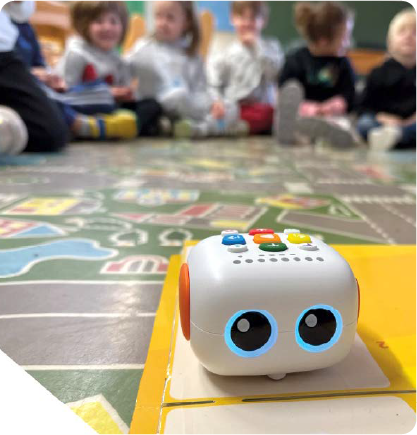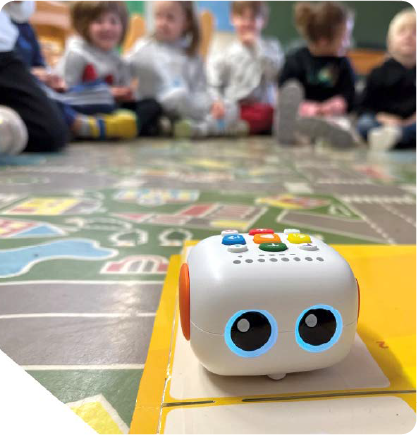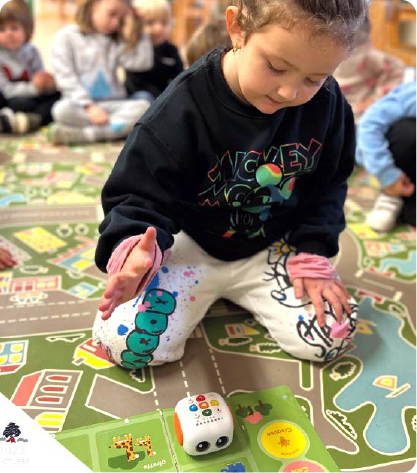
Location
Spain
How many kids are in a group
- 1st grade of pre-school: 33 students in 2 groups (17 y 17)
- 2nd grade of pre-school: 30 students in 2 groups (15 y 15)
- 3rd grade of pre-school: 44 students in 2 groups (22 y 22)
How was the Matatalab robot(s) used?
The adults in charge of developing the programme were the two pre-school ICT teachers. One teacher for 1st and 2nd grades and another for 3rd grade. These teachers carried out robotics activities adapted to the maturity level, age, interests and needs of each group, and were responsible for observing, collecting information, evaluating and analysing the data and results of this research.
The intervention consisted of the development of sessions in ICT periods. The first sessions were introductory to the use of devices and in the following sessions the children were able to explore concepts and practice programming.
To schedule the sessions, the specialists and the classroom tutors met to discuss where each class was at and what topics they were working on. In this way, the sessions were programmed taking this into account and trying to ensure that the content seen in the ICT sessions was as related as possible to the topics being worked on in their classrooms, in order to achieve more meaningful learning.
What skills did it develop?
In order to find out what skills this project developed, continuous observation was carried out and a rating scale was developed for the evaluation of the different sessions. This is a rubric made up of seven items, with a scale and values ranging from 1 to 6(1. not at all; 2. somewhat; 3. sufficient; 4. good; 5. very good 6. Excellent). The items to be assessed are as follows:
- Active participation in the proposed activities.
- Collaboration, interaction and teamwork.
- Use of the robot with a certain degree of autonomy.
- Interest, motivation and positive attitude and respect towards the robot.
- Showing attention during the activities.
- Understanding of concepts with the help of the robot.
- Development of problem-solving strategies.
- Development of imagination and creativity.
This rubric is applied by the ICT teachers, reaching a consensus on the assessment of the results obtained. In order to assess the influence of the educational robotics activities on the acquisition of skills in school children, the data and results obtained in this test are analysed.
After analysing the programme, it can be said that the results have been very positive. In general, all the children participated actively in the development of the activities proposed during the ICT sessions.
With regard to the development of the activities and the subsequent observation, we have observed in the results how most of the items are above average, considering these results to be very satisfactory, highlighting the pupils’ involvement and interest in the activities.
During this programme, it has been observed that the fact that the Tale-Bot Pro is small in size allows it to be easily manipulated and, as it has facial features, the children empathise much more and treat it with more care. In addition, many of the proposed activities required interaction and collective work. Considering all of the above, it can be concluded that the use of this didactic resource fosters the acquisition of socio-emotional skills such as empathy, communication and teamwork.
On the other hand, its colours, sounds and movements make it a suitable resource for use with young children between the ages of 3 and 6, as it is very attractive to them and keeps their attention during the activities.
A special feature of educational robotics is its ability to hold the learner’s attention. The fact that the learner can manipulate and experiment with robotics-based learning tools means that they can focus their perceptions and observations on the activity they are doing. Another feature is that it gives children the possibility to learn by playing and feel passionate about what they are doing.
Another factor to highlight is the positive reaction of many children to being able to solve a problem. Some showed frustration at not knowing how to get the robot to arrive or do what they wanted it to do. On the other hand, others kept trying and looked for other ways to do it, developing their imagination and creativity. Even the others showed a cooperative attitude, wanting to help each other. By the end of the programme, the vast majority were using the robot with a certain degree of autonomy.
Finally, it has been observed that the children who have participated in this programme understand, assimilate or revise concepts more easily, as this type of activity provides extra motivation and more meaningful learning. From the first session, in which the children were introduced to the programme, most of them were familiar with ICTs, but the robot was very new to them
What worked best and what was challenging?
At the beginning, as expected, there was a certain feeling of insecurity on the part of the ICT teachers, as they had never before worked or developed activities in pre-school classrooms (especially with the youngest children) with a robot. Little by little, they gradually gained more confidence in this respect. On the other hand, in general terms, what worked best in the classrooms were the activities in small groups. With regard to the advantages and disadvantages that the ICT teachers found in the pre-school classrooms, the following stand out:
Advantages:
- Very intuitive and attractive teaching resource for young children.
- Very complete and varied material, perfect for working on and expanding multiple topics and areas of knowledge. I
- deal for developing computational thinking and problem-solving skills, as well as social-emotional skills.
- Good resource for working on directionality.
Challenges faced:
- Little time to prepare the sessions (the two teachers are also tutors in their classrooms and do not have much free time to devote to ICT preparation).
- Insufficient human resources (one robot for 17 children at the same time is too much. Ideally, there should be another person in the classroom so that groups can be formed and all students can be properly attended to).
How did students respond?
Students responded very positively in all respects (motivation, skill development, knowledge acquisition…). This study demonstrates that it is possible to develop computational thinking skills from early school stages through robotics activities. The children who have participated in the pilot programme have acquired new skills to design and build programming sequences using tangible objects (robots / Tale-Bot Pro), being able to experimentally test the consequences and accuracy of the instructions developed, as well as to detect errors in the programming sequences. In conclusion, it is considered that the Tale-Bot Pro Pilot Programme is an example of how educational robotics manages to deepen the learning of the topics proposed in the curriculum, creating meaningful learning environments in which students stimulate their personal and emotional development.



 日本語
日本語

